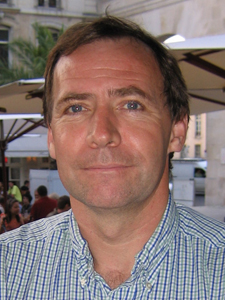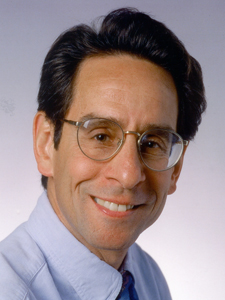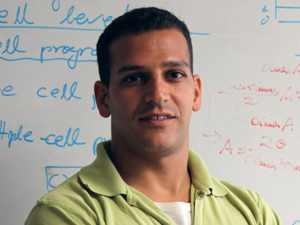Scientists Drawn to Magnetic New Data Storage Solutions
By Tiffany Fox, (858) 246-0353, tfox@ucsd.edu
San Diego, Calif., May 26, 2011 — One day in the not-too-distant future, the entire contents of the Library of Congress might be stored on a device the size of a postage stamp.
|
It seems far-fetched, but computer engineers at the Center for Magnetic Recording Research (CMRR) at the University of California, San Diego, are tucked away in a suite of windowless labs filled with whirring gadgetry, working hard to harness emerging nanotechnologies to build hard disk and flash drives that can store data at unprecedented levels. And they’ll be doing so under new leadership, beginning next month.
Eric Fullerton, who is a professor of Electrical and Computer Engineering (ECE) and NanoEngineering (NE) at UC San Diego, is expected to replace outgoing CMRR director and ECE professor Paul Siegel, who served the center for 11 years and helped establish its reputation as one of the world’s leading research institutions for magnetic recording.
The very underpinnings of our digital society rely on research in this somewhat arcane field, which focuses on increasing the capacity of data storage in a data-saturated world.
“Magnetic storage media are widely used in information systems at all scales – from supercomputers to desktop workstations to smartphones,” explains Siegel. “It’s a low-cost form of non-volatile memory, meaning that it can retain information even when the computer is not powered on.”
As one of his final duties as director, Siegel led the CMRR in its twice-yearly research review. The invitation-only review took place earlier this month and provided an opportunity for faculty and students from the Center to meet with CMRR’s industry partners, including Hitachi, LSI, Marvell Semiconductor, NHK, Seagate Technologies, Toshiba, and Western Digital, as well as representatives of the Information Storage Industry Consortium and the recently established Advanced Storage Technology Consortium.
Says Siegel: “The idea is to give a series of 15-20-minute presentations that describe the work we do at CMRR. It’s a great way of not only exposing our research to industry reps, but exposing students to industry.”
Two students -- ECE Ph.D candidates Eitan Yaakobi and Uwe Boettcher -- were awarded the Sheldon Schultz Prize for Excellence in Graduate Student Research at the research review for their work in error-correction coding for flash memories and dual-stage actuators for magnetic storage devices. The prize, which was established in 2003 in conjunction with the Center’s 20th anniversary celebration, is named in honor of former CMRR Director, Sheldon Schultz, and is presented to CMRR graduate students who have distinguished themselves through the creativity of their research and the impact of their publications.
“We have a great track record of sending our students directly into industry jobs, and the industry as a whole has been very successful,” notes Siegel. “I think it’s fair to say that the people who have come out of this center and other centers like it have made a significant difference in the evolution of these technologies.”
|
Siegel puts it another way: “IBM’s first disk drive, built in 1956, was the size of two refrigerators, cost more than $50,000 and held a total of 5 megabytes,” which is only enough storage capacity to handle about 30 seconds of broadcast-quality video. “Now you can buy a three-terabyte hard drive for $130 on Amazon.com” and have enough capacity to store the equivalent of an entire academic research library.
The growth of the data storage industry has been so explosive, in fact, that in many years, it has exceeded the trend in computing hardware known as Moore’s Law. Named for Intel Corp. co-founder Gordon Moore, the law predicts that the number of transistors that can be placed inexpensively on an integrated circuit will double approximately every two years.
By contrast, areal density of data storage has doubled on average every 18 months, and between 1997 and 2002, it doubled every year.
This cramming of more and more bits onto ever-shrinking hard drives has prompted the coining of a new law, known as Kryder’s law. The law, which is named for Seagate’s chief technology officer Mark Kryder, predicts that the growth of areal density will not follow a perfect logarithmic vertical scale, as is demonstrated by Moore’s Law, but will instead see several vertical jumps in growth as game-changing innovations are introduced.
Explains Siegel: “Growth jumped to 60 percent per year in the early ’80s with the introduction of several advances in magnetic recording, and when the Giant Magnetoresistive (GMR) Head was introduced, it jumped to 100 percent.”
CMRR’s incoming director, for one, was directly responsible for one of the field’s most important innovations. In 2001, while a researcher with IBM/Hitachi, Eric Fullerton helped invent a new type of magnetic medium called antiferromagnetically-coupled (AFC) media. AFC is a three-atom-thick layer of the element ruthenium sandwiched between two magnetic layers. This development alone made it possible for hard disk drives to store 100 billion bits (gigabits) of data per square inch of disk area by counteracting the superparamagnetic effect, which results when magnetic regions on a hard disk become too small and cannot retain data.
Fullerton’s advance made it possible for the upward arc of data storage capacity to progress, even as the devices themselves continued to become smaller. Siegel notes that this emphasis on ‘scaling’ has been another important advance in the field.
|
“The disks in hard drives used to be two feet across, and now they’re 2.5 inches across,” he points out. “We’re always striving to make things better, thinner and smaller. But because of the physics involved, we can’t scale things the way we used to.”
So what’s the theoretical physical limit for the density of data storage? It all depends on where and how the data are being stored. Now that the milestone of 100 Gigabits per square inch in commercial disk drive technology has been achieved and the most advanced hard drives can store up to 600 Gigabits per square inch, researchers at CMRR and elsewhere are striving toward -- and are only a factor of two away from -- the ambitious goal of 1 Terabit (1 trillion bits), which is thought to be the physical limit for data storage using current technologies.
This limit exists primarily because the magnetized areas on hard disks are becoming so small that it is difficult for them to remain stable as the read/write head flies across the surface of the disk. Flash drives use electrically charged transistors rather than moving parts to record information, making them a bit more stable (and better for mobile technologies, such as smartphones, says Fullerton) but also more expensive.
“Making predictions about the death of hard drives is a very old and prosperous field,” jokes Fullerton. “Being a factor of two away from what’s perceived as the limit is very daunting. What happens after we reach that threshold is that density will increase much more slowly, capacity will change much more slowly. To get around that, we have to do something new.”
|
“Currently, the cost to directly make the pattern on one disk is about $2 million,” he notes. “Somehow we have to bring that cost down from $2 million to $1.”
Another approach, Heat Assisted Magnetic Recording (HAMR) maximizes density by harnessing a laser to write data onto a disk. But this is no small feat -- for the data to be written, the laser must heat a point 50 nanometers in size to 200 degrees Celsius in one nanosecond, and then cool it down in one nanosecond.
“That gap between nanoseconds is when the data are written” explains Fullerton.
He says that it’s not clear that either approach will work, but overcoming these initial hurdles in recording data at the nanoscale is a necessary step if computer engineers are to achieve the final frontier: Storing data near the atomic or molecular level. According to IBM, such a storage capability would enable nearly 30,000 feature length movies or the entire contents of YouTube – millions of videos estimated to be more than 1,000 trillion bits of data – to fit in a device the size of an iPod.
Although engineers are still a factor of 10,000 away from building data storage drives at the atomic level, the question now becomes: Do people actually need such gargantuan storage capability? Is it really necessary to carry around 30,000 feature-length films in one’s back pocket?
“I can remember when people would ask, ‘Why would you ever need a 1 gigabit hard drive?” recalls Fullerton. “But it’s true that there might come a point where the level of current storage capacity is ‘good enough.’ After all, nobody goes around saying, ‘Why aren’t airplanes any faster than they were 20 years ago?’ We could all travel around in planes that fly faster than the speed of sound, but that would be incredibly expensive, and not necessarily any more efficient.
“For all of this to go forward, either people have to be more efficient at storing data, or they have to store less of it.”
As their most recent research review demonstrated, computer engineers at CMRR are actively working to overcome barriers related to cost, efficiency and stabilization as data storage moves into its next incarnation. Several presentations, for example, addressed new methods for not only determining the height of the read/write head, but also ways for controlling it.
Knowing the height of the head -- which Siegel describes as a ‘glorified electromagnet’ -- is crucial to hard drive functionality, says Siegel. “One of the worst things that could happen is if the head crashes. It could wipe out the disk.”
Presentations also focused on recording channels, the mechanics of disk and tape drives, high-speed high-resolution instrumentation, and simulations of the physics involved in the data-recording process.
There were also technical sessions featuring CMRR’s research on other non-volatile storage technologies, such as magnetic random access memory (MRAM), phase-change memory (PCM), and flash memory. “These solid-state, non-mechanical memory technologies are increasingly important in applications ranging from consumer electronics to large-scale enterprise storage systems,” said Siegel. “They require a complete rethinking about the way future data-intensive computers can most effectively harness the potential of these new storage technologies.”
CMRR is teaming up with other research groups on campus to do just that. Among them is the San Diego Supercomputer Center, which is leading a $15M NSF-funded effort to build a data-crunching computer, nicknamed “Gordon,” that relies on massive amounts of high-speed solid-state memory, in essence a huge flash drive. There is also the Non-Volatile Systems Laboratory in the Computer Science and Engineering Department, where researchers are exploring performance characteristics of new solid-state storage devices and using their findings to help future computers handle data faster and in larger quantities. Together with these centers and the California Institute for Telecommunications and Information Technology (Calit2), CMRR co-organized and hosted the recent UCSD Non-Volatile Memories Workshop (NVMW 2011), which attracted over 225 participants from academia, industry, and government research labs.
“With the technical expertise, innovative thinking, and collaborative spirit at CMRR and these other campus research centers, UC San Diego is arguably the premiere university world-wide in all aspects of advanced data storage technology and systems,” says Siegel. “This is a very exciting direction for the campus, and an exciting time for the storage industry as a whole.”
Media Contacts
Tiffany Fox, (858) 246-0353, tfox@ucsd.edu
Related Links





